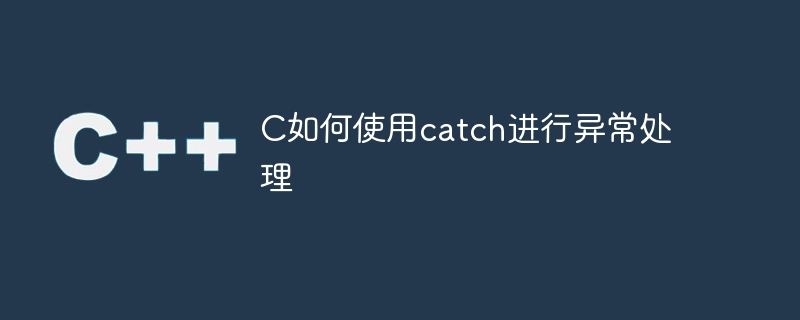Home >Backend Development >C++ >C exception handling using catch statement
C exception handling using catch statement
- WBOYWBOYWBOYWBOYWBOYWBOYWBOYWBOYWBOYWBOYWBOYWBOYWBOriginal
- 2024-02-18 15:59:05545browse

How to use catch for exception handling in C requires specific code examples
In C language, exception handling is a mechanism for handling errors when a program is running. Although the C language itself does not have a built-in exception handling mechanism, you can use some techniques to achieve similar functionality. One of the common methods is to use the setjmp() and longjmp() functions together to catch and handle exceptions.
The prototypes of the setjmp() and longjmp() functions are:
#include <setjmp.h> int setjmp(jmp_buf env); void longjmp(jmp_buf env, int val);
The setjmp() function will set a jump point in the program, and its parameter is a jmp_buf type variable env. jmp_buf is a special data type that can store jump point information. The return value of the setjmp() function indicates that the current position is initialized as the jump point. If the setjmp() function returns 0, it means that the current position is entered through a function call; if it is non-0, it means that the current position is jumped to through the longjmp() function.
The longjmp() function jumps the program to the location where the setjmp() function is called, and can pass a value to the setjmp() function to determine the reason for the jump. The variable env of jmp_buf type must be initialized using the setjmp() function before the jump position, otherwise the result is undefined.
The following is a specific example showing how to use the setjmp() and longjmp() functions for exception handling:
#include <stdio.h>
#include <setjmp.h>
jmp_buf env; // 设置全局jmp_buf类型变量
void functionB() {
printf("In function B
");
longjmp(env, 1); // 跳转回functionA并传递错误码1
}
void functionA() {
printf("In function A
");
if (setjmp(env) == 0) { // 第一次调用setjmp,返回0
functionB();
} else { // 当由longjmp跳转回来时,返回非0,表示捕获到了异常
printf("Exception caught!
");
}
}
int main() {
functionA();
return 0;
}Running the above code will output the following results:
In function A In function B Exception caught!
In the above example code, when the program executes functionB(), it calls the longjmp() function and jumps back to the calling location functionA(). Since the error code passed by longjmp() is 1, the return value of the setjmp() function is non-0, and the exception is caught.
It should be noted that the above method is only applicable to exception handling in C language and cannot handle all possible exceptions. In addition, setjmp() and longjmp() need to be used with caution. Improper use may lead to memory leaks or other unpredictable results.
In summary, C language can achieve functions similar to exception handling by using the setjmp() and longjmp() functions, which are used to capture and handle errors when the program is running. However, the use of exception handling mechanisms requires caution, and in actual development, appropriate exception handling methods should be selected based on specific circumstances.
The above is the detailed content of C exception handling using catch statement. For more information, please follow other related articles on the PHP Chinese website!
Related articles
See more- C++ compilation error: A header file is referenced multiple times, how to solve it?
- C++ compilation error: wrong function parameters, how to fix it?
- C++ error: The constructor must be declared in the public area, how to deal with it?
- Process management and thread synchronization in C++
- How to deal with data splitting problems in C++ development

